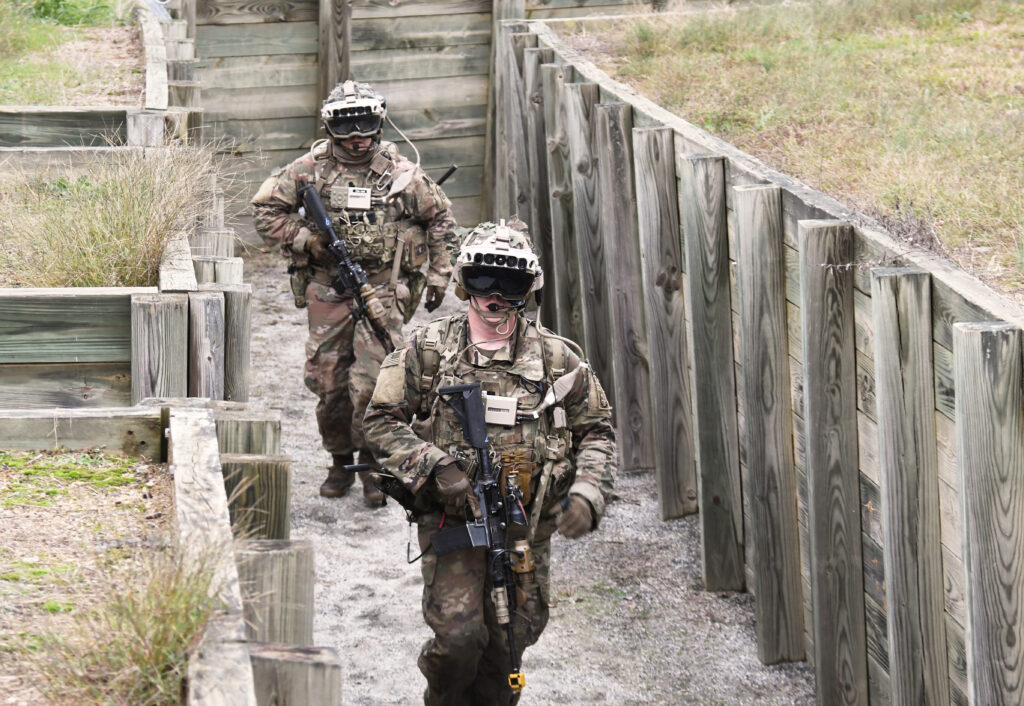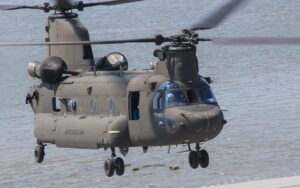
Soldiers check out the latest, ruggedized version of the Integrated Visual Augmentation System (IVAS) during trials at Fort Pickett.
WASHINGTON: The Army may have to slash troop strength and training to save its ambitious modernization program from the likely post-COVID budget crunch.
Painful choices are already painfully familiar to the Army. Even in the flush years of the Trump Administration, the Army largely funded its new weapons by cutting lower-priority programs. In 2021, the service will face Democratic control of the White House, the House of Representatives, and — potentially — the Senate, amidst the national fiscal hangover from trillions in COVID stimulus spending. The Army’s own former Chief of Staff, Joint Chiefs Chairman Gen. Mark Milley, has predicted a “bloodletting” of ground-force programs to fund sea, air, and space technologies more essential to counter to China.

Gen. John “Mike” Murray (left) speaks to Army Secretary Ryan McCarthy (right). Trump appointees like McCarthy have been strong supporters of Army modernization — but they’ve leaving.
In previous drawdowns, long-term modernization programs have often paid the bill to protect near-term readiness and troop numbers. The head of Army Futures Command, Gen. Mike Murray, has repeatedly and publicly said he’s prioritizing which new weapons to protect. But with an aging inventory on Reagan-era equipment that’s inadequate against the current Russian threat and largely irrelevant against China, Army leaders have promised to protect modernization this time around … somehow.
But how? The Army’s modernization priorities will move from PowerPoint to prototype to production over the 2020s, with corresponding increases in costs. Meanwhile, there are few low-priority weapons programs left to cut after two years of grueling Night Court reviews. The big-ticket items that remain have strong constituencies in Congress. For example, they assured added funding to the very CH-47 Chinook helicopter the Army sought to cut. With such sacrifices off the table, the only way to fund modernization may be to cut readiness or personnel. But skimping on training and shrinking the force are both politically toxic – far more so than cuts to R&D programs that haven’t yet entered production and created blue-collar jobs.
Still, there is a silver lining in 2021’s storm clouds for the Army. President Trump’s budget plan for 2022, which trimmed Army troop strength by 1,300 while massively plussing up the Navy, is dead on the arrival. That is, it’s dead on arrival if it ever even arrives on Capitol Hill. The incoming Biden administration will almost certainly issue its own 2022 spending plan.

Lloyd Austin after being nominated by President-elect Joe Biden in Delaware on Dec. 9
What will that look like? Presidential candidates rarely talk in any detail about defense priorities – especially in a year of domestic unrest and global pandemic. Biden passed over the reform-minded Michele Flournoy for Defense Secretary, and his current pick, retired Army four-star Lloyd Austin, is a self-effacing career man unlikely to push anything radical.
But cuts of some kind are almost certain to be on the table as Democrats wrestle with the costs of COVID. Sure, the party’s moderates easily rebuffed a Bernie Sanders-led attempt to cut defense sending by 10 percent. That doesn’t mean the party will boost Pentagon spending. Sure, Democrats accused Trump of neglecting the Russian threat and don’t want to be seen as soft on China. That doesn’t mean they’ll favor the Army, which they associate with interminable, unpopular land wars in Afghanistan and Iraq, as well as decades of failed modernization efforts.

The latest variant of the Boeing Chinook, the CH-47F Block II, in test flight.
With the Biden White House consumed by domestic issues and a political neophyte as Secretary of Defense, the crucial battleground is likely to be Congress. That’s an uphill fight for the Army, which has seen legislators cut its cutting-edge programs – like the IVAS targeting goggles – and plus up old-school hardware like the Chinook.
“Have you seen a successful program emerge from all the investment in innovation?” asked one skeptical former Hill staffer. “The services have made good investments in commercial technology but we haven’t seen the transition to major programs, especially in the Army.”
It’s not just Army modernization that will take the hit, the staffer told me, but all the services’ long-term Research, Development, Test, & Evaluation (RDTE) – which is politically easier to cut than programs already in production. “DoD, not just Army, RDTE will suffer because the Congress is not ready to give up legacy programs until the service modernization programs mature,” they said.

The two contenders for the Future Long-Range Assault Aircraft (FLRAA): The Sikorsky-Boeing SB>1 Defiant compound helicopter (top) and the Bell V-280 Valor tiltrotor (bottom)
“Manpower will be the bill payer of choice for the administration, because that gets you the fastest savings,” the staffer predicted. “You see most of the reductions in the active force because like legacy systems, you can’t cut the National Guard.”
But cutting regular active duty soldiers won’t be enough to keep the Pentagon’s Pacific priorities afloat, the staffer warned: “The Air Force and Navy have big bills that can’t be solved by Army end strength.”
That means the Army may have to sacrifice some of its high-priority weapons programs. Which ones? The Hill staffer predicted that one of the two Future Vertical Lift aircraft – the FLRAA transport or the FARA scout – would have to go, while the Optionally Manned Fighting Vehicle to replace the Reagan-era M2 Bradley has already been delayed. Also, while the INF Treaty is dead beyond any hope of resurrection, arms-control advocates in the Biden Administration will be leery of the Army’s proposed arsenal of new long-range missiles, and budget hawks may see them as duplicating Air Force and Navy strike capabilities.

Tom Mahnken
To save these programs, generals can’t just assert they’re important to the Army, argued Tom Mahnken, a veteran of Navy and Pentagon service who heads the Center for Strategic & Budgetary Assessments. They have to convince the White House and Capitol Hill that these ground-based technologies can make a valuable contribution to the all-service joint effort across land, sea, air, space, and cyberspace – especially in the Pacific, traditionally a Navy-led theater. Otherwise, the ground force may indeed face Gen. Milley’s prophesied budget bloodbath to fund sea-, air-, and space-power.
“The amount of ‘bloodletting’ that Army programs experience will depend crucially upon the Army’s ability to tie its budget, to include its modernization priorities, to new concepts of operations, such as Multi-Domain Operations, as well as the Joint Warfighting Concept,” Mahnken told me. “Those capabilities that are tied closely and obviously to these new concepts should be favored. Those that are not will be in greater jeopardy.
“The Army will need to make a compelling case to Congress to fund new capabilities and truncate legacy programs,” Mahnken said. “They will need to show Congress how new capabilities are integral to new concepts of operations and organizations.”






















